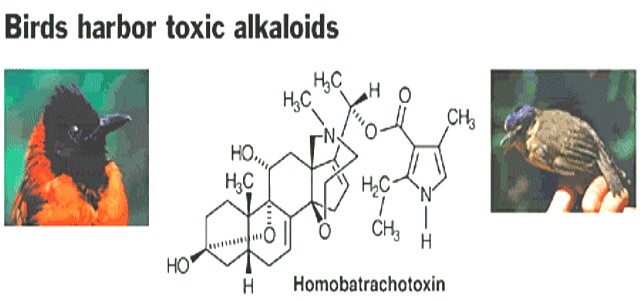Amphibian Neurotoxins
I will never forget the wonder that filled me the first time I saw a poison arrow frog. Black and green were traditionally colours I associated with camouflage, but not in this case. The day-glo green was quite startling in its intensity. As a child growing up with a deep fascination for all things venomous or poisonous, the arrow frogs were certainly near the top of my list. I read with great admiration the clever use of the deadly toxins from these frogs by some amazonian tribes to tip their arrows a very effective hunting strategy! However, as I grew older and my scientific training began in earnest, I came to asking questions about these beautiful amphibians and their toxic secretions. In actuality, my first real scientific amphibian quest started (as all quests do) with the basic question of what would happen to me if I licked one, any one, of these poison arrow frogs? The answer to this question (I thought) was best explored in a scientific manner (rather than the old hands on approach) by asking were all poison arrow frogs the same? Where did their toxic skin secretions come from? How toxic were they in reality? And what can we do with this wonderful pharmacopoeia.
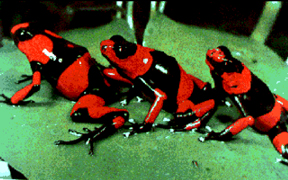
What makes a poison arrow frog a poison arrow frog?
Of course every brightly coloured frog is not a poison arrow frog. First off, the frogs are referred to as poison arrow frogs, poison dart frogs, dart poison frogs, and other variations upon this general theme. It is a matter of semantics as to which is correct, however identifying between the different genre in this family is where I wouldn't want to make a mistake in my taxanomic identification. The true poison arrow frogs are found in the Dendrobatid family that traditionally included the genera Dendrobates, Epipedobates, Minyobates and Phyllobates. The taxonomical debate for these little dynamos has long been a matter of great discussion yet recent work based upon mitochondrial DNA has gone a long way towards resolving the issues, but much still remains to be done. What is certain is that, proclamations on pet store list to the contrary, the species of Atelopus (Harlequin toads), Mantellas and others are not poison arrow frogs.
The myriad of colors that can be found in the poison arrow frogs greatly confuses the taxonomy. However for the most part, the colour variation seems to be independent of the level of genetic variation between the populations. These colour schemes may instead play a significant role in the breeding behaviour of the frogs. Probably the most fascinating variation occurs in Dendrobates imitator. This frog,, while toxic itself, imitates the colour schemes of other poison arrow frogs in Peru. In Tarapoto it imitates D. variabilis, in Huallaga Canyon, Dendrobates fantasticus and in Yurimaguas, Dendrobates ventrimaculatus. This is called Mullerian mimicry and is a fascinating feature of adaptation. It means that where two toxic or unpalatable species mimic each other, they have to 'educate' fewer predators about their deadly toxins. This way, the survival rate is greater and these species usually have a larger geographical range because of this. This is in contrast to Batesian mimicry where a very tasty species imitates an unpleasent or toxic species in order to try and get some protection against predation. The poison arrow frog family has the only case of Mullerian mimicry in an amphibian, a feature of adaptation that is a rare event in all vertebrates in any case. Just another peek into the amazing evolution of these wonderful frogs.
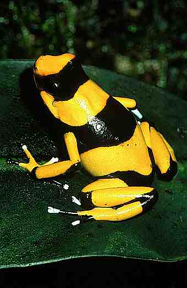
Poison arrow frogs are quite unusual in many aspects, not just in their colouring or in the presence of powerful toxins on the skin. Unlike the vast majority of other frogs, they are active during the day and don't live in the water. Instead they prefer to hop around the leaf litter, in the low shrubbery or even, in some cases, venturing high up into the rainforest canopy to dwell around the bromeliads. (A photographer's dream - although vertigo suffers may be limited to the ground dwelling species!) The level of parental care is often much higher than is the norm for frogs. In some cases, the male guards the eggs or tends to the young while in others the female periodically visits to care for the tadpoles in such unique ways as laying unfertilised eggs for them to eat!
Where do the toxins come from and what do they do?
By and large the toxins secreted by the Dendrobatid frogs appear to come from their insect diet such a. It has been shown that they soak up the alkaloids through their digestive process, these then are used to produce the toxins and are then storedt in glands just below the surface of the frog's skin. When the frog is threatened, ie a predator (say a snake for example) has taken it in its mouth, the toxin will be triggered and seep out, giving the predator more of a mouthful than it had expected. Usually enhancing the frog's lifespan by being spat out.
As a general rule the toxins on the skin of the poison arrow frog are there as a deterrent against predation. If you were to lick one (no need to try just the back the toxin is secreted all over the frog) it is most likely that you would get the feeling of even more of an upset tummy than you would normally get from licking a live frog. In some cases however, the toxin can kill a predator through paralysis. For example Phyllobates terribilis secretes a toxin called Batrachotoxin. At about 250 times the potency of strychnine, it's certainly a toxin to be reckoned with.
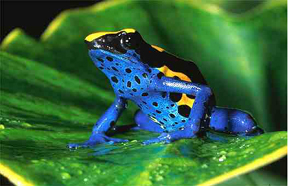
Do the toxins disappear in captivity?
This is one of the biggest questions, ie what is genetic and what is from the environment? It has been shown in laboratory studies that poison arrow frogs will readily assimilate alkaloids yet captive borne and raised frogs that were not exposed to alkaloids in their diet, completely lacked the toxins. Further to this, while the toxins on the skin of wild caught frogs can persist for years in some cases, there is a steady decline. Frogs from the genus Phyllobates terribilis that have been kept in captivity for up to six years were still five times more toxic than wild caught representatives of other species used by the natives for poisoning arrows. This shows that some wild caught frogs have to be treated with due respect at all times. However, captive bred progeny completely lack the toxins.
What's in the poison arrow frog's toxic skin secretions?
The Dendrobatidae toxins are an incredibly diverse set of small organic molecules called alkaloids, molecules characterised by a ring shape. However the armory of toxins can even contain tetrodotoxin, the same toxin that makes a puffer fish so deadly to eat and a blue-ringed octopus' bite so dangerous. Tetrodotoxin was first isolated in a poison arrow frog from the skin of Colostethus inguinalis but was later shown to also be present on the skin of Atelopus (harlequin toads) species.
The poison arrow frog toxins of the Dendrobatid family are an extremely diverse set and vary considerably between species or even within different populations of the same species. For example the populations of D. auratus in Isla Taboga (a Pacific Island), a population from the Panamanian central mountains and on the Costa Rican Carribean coast have slightly different the toxic secretions (presumably caused by difference in diet). Where this gets very interesting is that the Isla Taboga population of D. auratus was introduced into Hawa'ii in 1932. Intriguingly, offspring of captive and thus toxinless D. auratus raised in large outside terrariums in Hawa'ii and fed wild-caught termites and fruit flies, contain the same spectrum (but of reduced intensity) as wild caught introduced poison arrow frogs in Hawa'ii. This shows the remarkable ability of Dendrobatid frogs to harness any alkaloid that comes their way.
The toxins found in poison arrow frog secretions are alkaloids and are, as a result, some of the most powerful cardiotoxins known, binding to nerve channels with the sodium channel being most affected. These toxins paralyze through a selective increase of the permeability of the Na+ channel, inducing the persistent transmission of a nerve signal. This constant stimulation leads to uncontrollable muscle spasms eventuating in the depletion of neurotransmitter stores. By way of comparison, scorpion toxins produce the same net effect as the poison arrow frogs but rather than constantly turning on the nerve signal process these toxins inhibit the process required to turn the sodium channel off.
The major dendrobatid alkaloids are batrachotoxin, decahydroquinolines, histrionicotoxins, indolizidines, pumiliotoxins, pyrrolizidines, quinolizidines and tetrodotoxin. Pumiliotoxins are widespread alkaloids found in a number of species and increase the rate of sodium channel opening and closing, producing spontaneous activity of the nerve. Batrachotoxin is another member of this group of potent lipid-soluble neurotoxins that bind voltage-sensitive sodium channels. Batrachotoxin is the most powerful animal venom known, being 250 times more powerful than strychnine and is present in high concentrations in Phyllobates terribilus accounting for the extreme toxicity of this species.
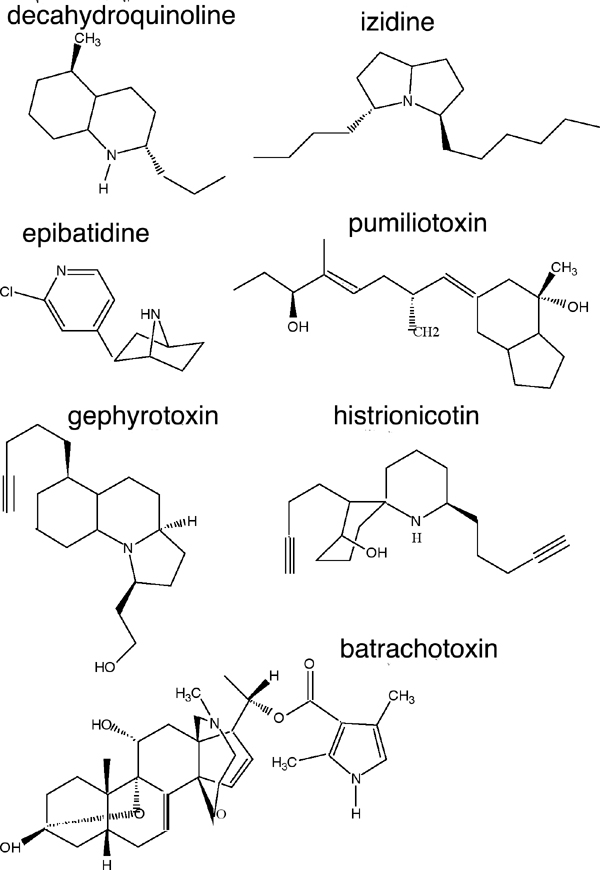
The diversity of poison arrow frog alkaloids, ranging from the small and deceptively simple decahydroquinoline to the large and extremely complex batrachotoxin.
While sodium channels are commonly targeted, frog toxins also affect potassium channels. Dendrobates histrionicus (Colombian arrow poison frog) contains two main alkaloids unique to this species: gephyrotoxin and histrionicotoxin. Gephyrotoxin is a novel tricyclic alkaloid that, like histrionicotoxin, blocks the voltage-sensitive potassium conductance of the indirectly elicited muscle twitch in a concentration-dependent manner.
The frog toxins are not limited to presynaptic activity with postsynaptic toxins also isolated. Epibatidine, from the poison arrow frog Epipedobates tricolor found in El Salvador, is a neuronal nicotinic acetylcholine receptor agonist upon chicken alpha4beta2, alpha2beta2 and alpha3beta4 subunits or human alpha3beta2 and alpha3beta4subunits. The analgesic effect is 120 times more potent than nicotine. Epibatidine is less potent in action upon the alpha-BuTX-sensitive alpha7 subunit yet is still more potent than either acetylcholine or nicotine upon the receptor.
What can we do with this wonderful pharmacopoeia.
The poison arrow frog toxins (such as the dendrobatid toxin) have also been included in the search for pain killers. Epibatidine, isolated from Epipedobates tricolor, has 120 times the pain killing ability of nicotine. This makes it of tremendous interest as a potential drug lead. However getting the toxin in steady supply is a real problem because of the fact that the frogs lose the toxins in captivity and captive borne frogs lack toxins entirely. Therefore, the only way to discover new wonder drugs from this incredible natural pharmacology is to collect more frogs. The catch-22 of course is that frog populations worldwide are crashing from habitat destruction as 2000 year old rainforest trees get felled for woodchip and other such 'useful' items. As with just about everything else that is wild and beautiful, time is running out for these precious jewels. Unless we can stop the mindless mentality that growth is good, then we will lose it them all, the promise that they hold out for medicine, science and the natural diversity of life that keeps this planet in balance.
A poisonous bird?!
To reinforce what a what a great world it is that we live in, check this out. The pitohui bird (Pitohui dichrous) and related species in New Guinea actually have on their feathers some of the same sorts of toxins as poison dart frogs!
